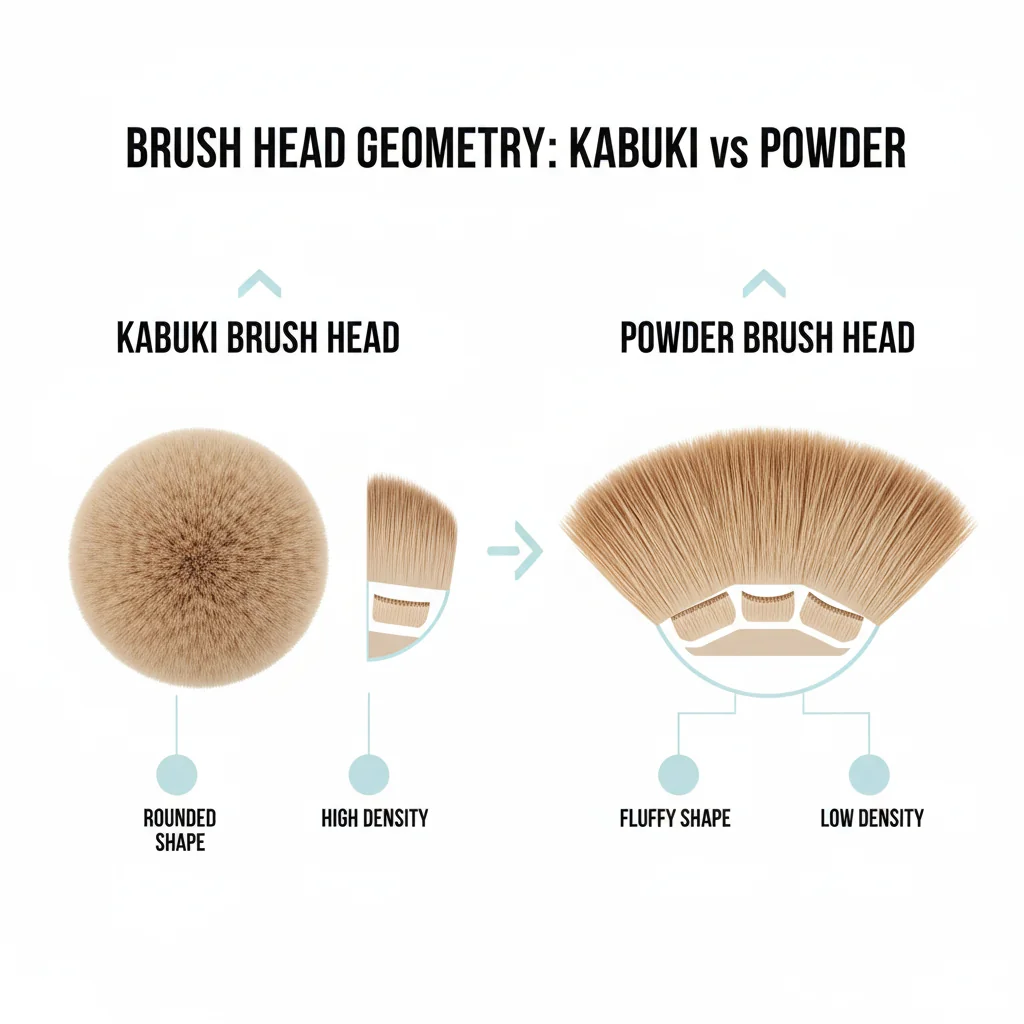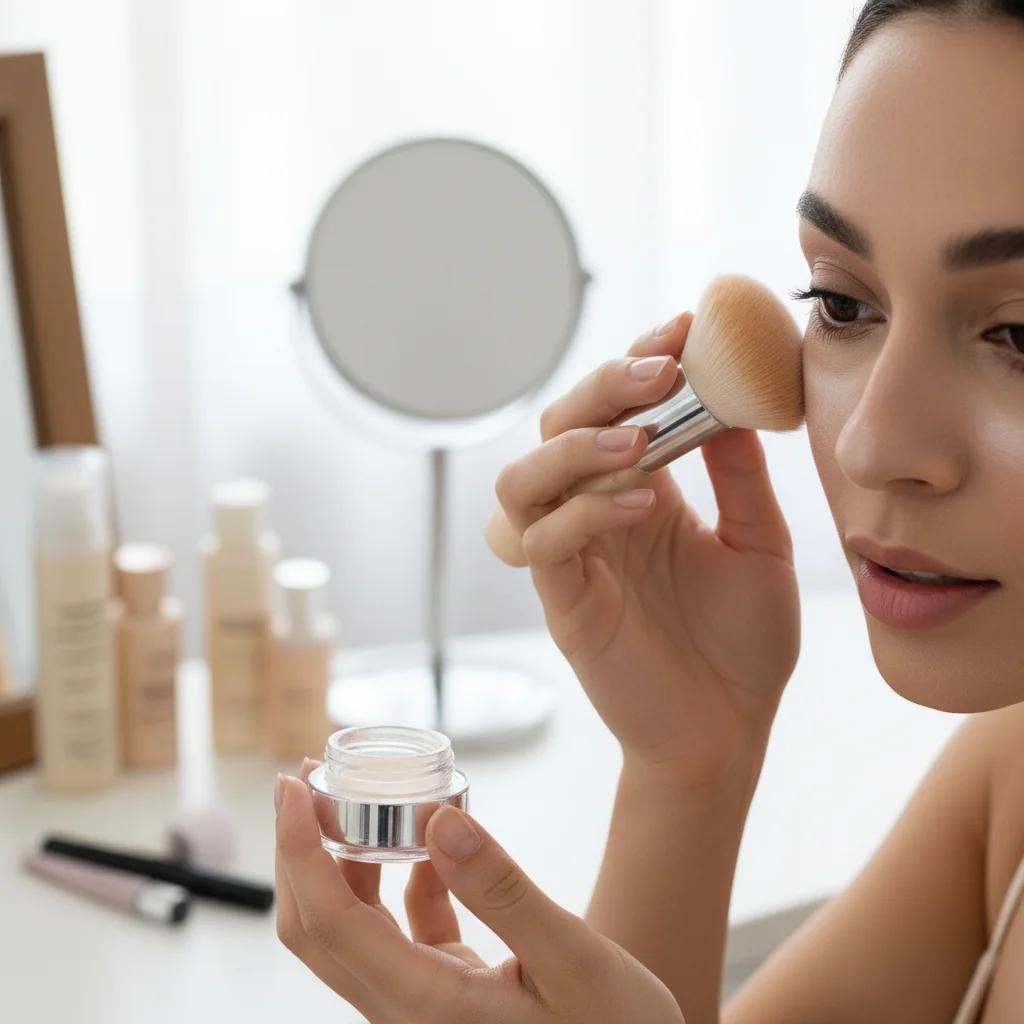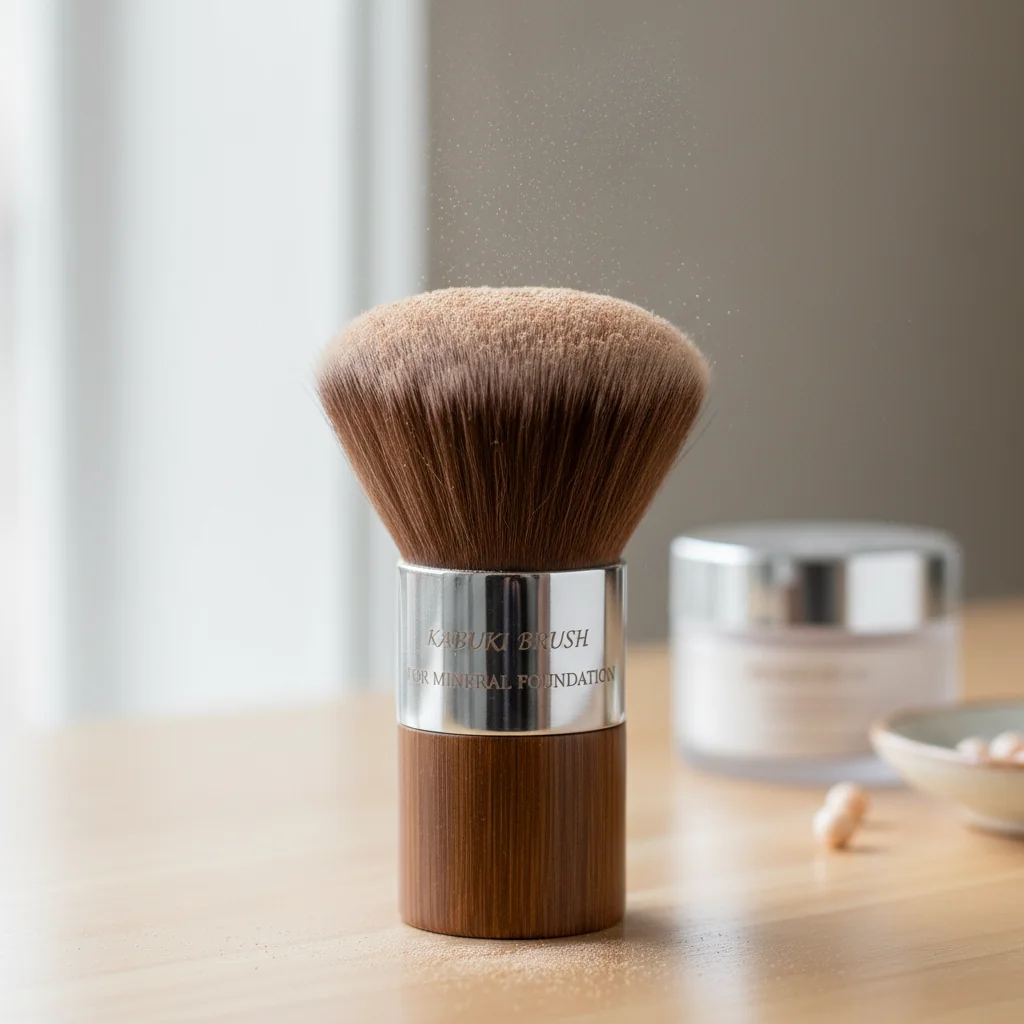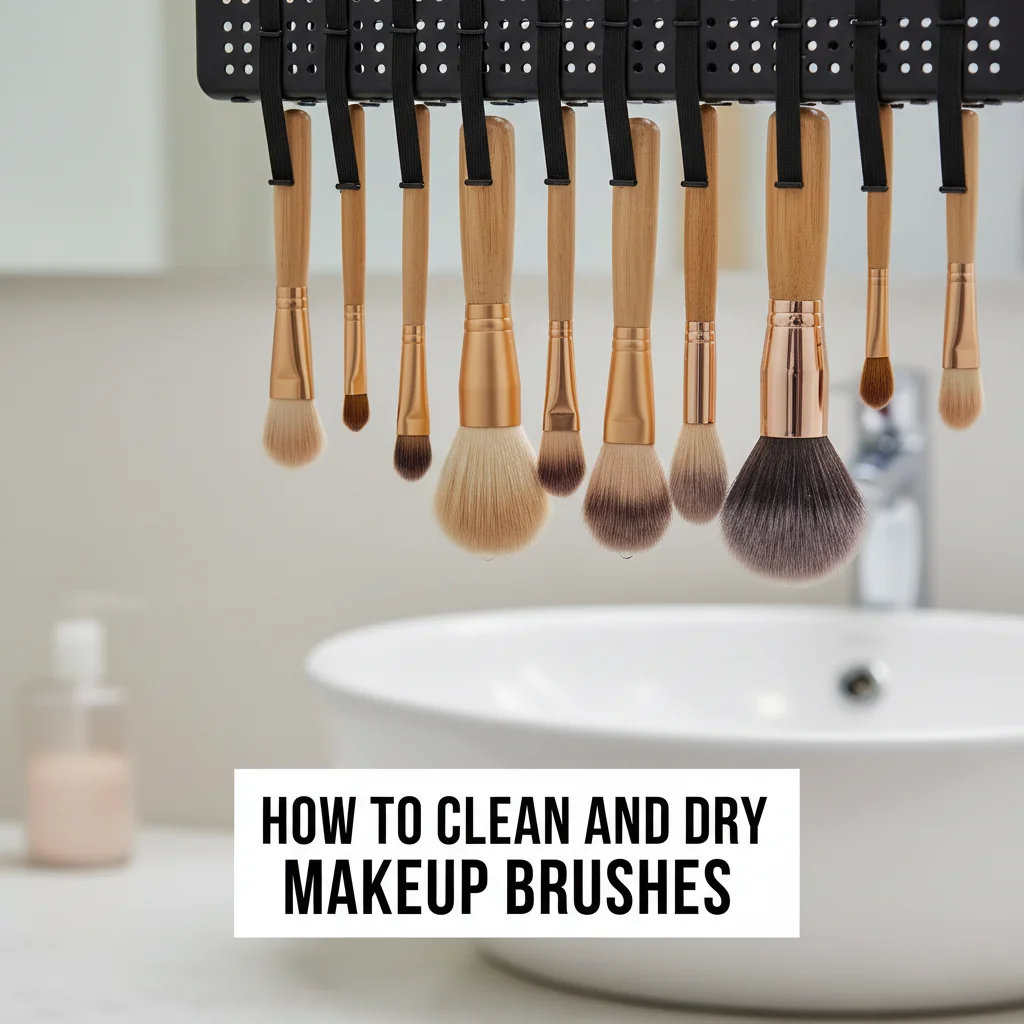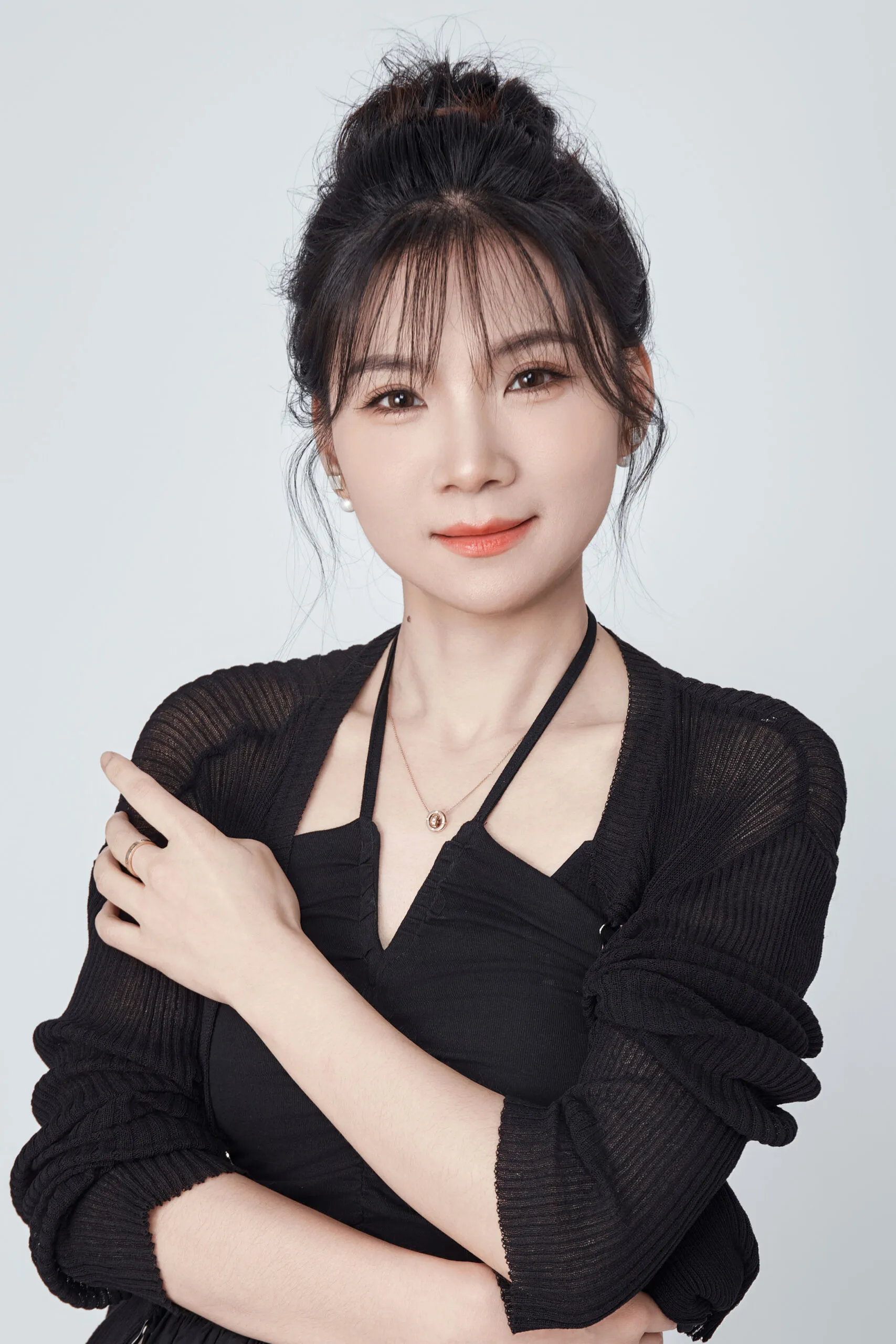Choosing the right brush for your beauty line feels overwhelming. Pick the wrong one, and you risk customers complaining about cakey results or poor coverage, damaging your brand’s reputation.
Choose a kabuki brush1 for fuller, buffed coverage and multitasking across powder, liquid, and mineral foundations. Choose a powder brush for a light, even setting or a sheer veil of powder; its fluffy head diffuses product without buildup.
Now you know the basic difference, but as a brand owner, the details are what matter for your bottom line. When I started on the factory floor, I saw how a tiny change in bristle density2 or handle length could completely transform a brush’s performance and a customer’s experience. These are the details that separate a good product line from a great one. Let’s break down what you need to know to make the right sourcing decisions for your brand.
A kabuki brush and a powder brush are interchangeable for all types of powder.False
This is false. A kabuki's density is for buffing and coverage, while a powder brush's fluffy design is for sheer application. Using the wrong one will produce very different results.
The density of a brush's bristles is the primary factor determining its coverage level.True
This is true. Denser bristles pick up and deposit more product onto the skin, creating fuller coverage. Looser, fluffier bristles deposit less product for a sheerer finish.
Can you use a kabuki brush for setting powder?
You want to offer a versatile brush for setting powder, but wonder if a kabuki is the right choice. A wrong recommendation can lead to customers complaining their makeup looks heavy or doesn’t last.
Yes, a kabuki brush works for setting powder, especially if you want a fuller, matte finish. The key is to use a gentle pressing or rolling motion to pack on powder without disturbing the foundation underneath.
Technique is Everything: Press vs. Sweep
The label on a brush matters less than the way you use it. While a kabuki brush can be used for setting powder, you can’t just swirl it on like you would with a fluffy powder brush3. If you try to buff powder over a liquid or cream foundation that hasn’t fully set, the dense bristles will grab the base and move it around, creating streaks and patchiness. I’ve seen this happen countless times.
The solution is to change the motion. Instead of buffing, use a "press and roll" or gentle tapping motion. This presses the setting powder directly into the skin, locking your foundation in place without lifting it. This technique is perfect for "baking" or for adding extra hold to oily areas like the T-zone. When you’re creating marketing materials or product descriptions for your brand, explaining this simple technique is a huge value-add. It prevents customer error and helps them get the professional results your brand promises.
Buffing setting powder with a kabuki brush is the best way to get a natural finish.False
This is false. Buffing with a dense kabuki brush over a liquid base can disrupt the makeup. A pressing motion is better for setting, and a fluffy powder brush is better for a natural finish.
Using a pressing motion with a kabuki brush can help 'bake' or set makeup in transfer-prone areas.True
This is true. The pressing technique deposits a concentrated amount of powder, which is ideal for setting makeup in areas that tend to get oily or where makeup easily wears off.
Is a powder brush or kabuki better for mineral foundation?
mineral foundation4 needs a specific application to achieve that flawless, skin-like look. Using the wrong brush can result in a splotchy, uneven finish, making your high-quality mineral formula look cheap.
A kabuki brush is definitively better for mineral foundation. Its dense bristles are designed to pick up the perfect amount of mineral powder and buff it into the skin for seamless, buildable coverage.
Why Density Drives Mineral Makeup Performance
Mineral foundation works differently than traditional powder. It needs to be warmed up and buffed into the skin to adhere to its natural oils, which creates that famous airbrushed finish. A large, fluffy powder brush simply can’t do this; it will just dust the product around without providing any real coverage. This is where the kabuki brush shines. Its dense head and short handle give the user maximum control for the necessary circular buffing motions.
For my clients launching mineral makeup lines, I always recommend a flat-top or gently domed kabuki. Here are the specs we focus on:
| Specification | Why It Matters for Mineral Foundation |
|---|---|
| High Bristle Density | Picks up more product and provides the resistance needed for buffing. |
| Soft synthetic fibers5 | Cruelty-free, durable, and won’t irritate skin during the buffing process. |
| Short, Sturdy Handle | Offers better control and pressure for an even, seamless application. |
| Double-Crimped Ferrule | Secures bristles tightly to prevent shedding, which is critical during vigorous buffing. |
When you’re sourcing brushes, asking your manufacturer about these specific details ensures you get a tool that performs perfectly with your formula.
A large, fluffy powder brush provides the best coverage for mineral foundation.False
This is false. A fluffy brush lacks the density required to effectively buff mineral pigments into the skin for good coverage.
The short handle of a kabuki brush offers better control for the circular buffing motions required for mineral foundation.True
This is true. The proximity of the hand to the brush head allows for more precise pressure and control, which is essential for a flawless mineral foundation application.
Which brush gives a lighter, natural finish?
Your customers want that effortless "no-makeup" makeup look, but their tools are packing on too much product. A heavy-handed application can ruin a beautiful sheer formula, leading to returns and complaints of "cakey" makeup.
The powder brush, with its long, fluffy, and less-dense bristles, is specifically designed to give a lighter, more natural finish. It picks up less product and diffuses it for a sheer veil of color.
The Anatomy of a Sheer Finish
The secret to a light application lies in the brush’s construction. A powder brush is the opposite of a kabuki. It has longer, wispier bristles that are loosely packed. This design has two effects: first, it picks up far less product from the pan. Second, the long, flexible bristles splay out and deposit that small amount of product over a wider area in a soft, diffused way. This makes it almost impossible to apply too much.
This makes the powder brush the perfect tool for setting the entire face with a translucent powder, controlling shine on the T-zone without adding texture, or applying a subtle hint of bronzer or blush. From a brand perspective, this brush is a key part of a well-rounded collection. You can position it as the "finishing touch" tool. For a higher average order value, consider bundling it with a denser foundation brush (like a kabuki). This provides your customer with a complete solution: one brush for coverage, and one for a sheer, natural set.
You can get the same sheer finish with a kabuki brush by just using less product.False
This is false. The dense head of a kabuki is designed for product pickup and deposit, making a truly sheer, diffused application very difficult to achieve, regardless of how little product you use.
A tapered powder brush allows for more targeted application of setting powder, like under the eyes.True
This is true. The tapered shape of some powder brushes allows for more precision, making them ideal for setting smaller, specific areas of the face without disturbing other makeup.
How often should makeup brushes be cleaned?
Customers use your beautiful brushes daily, but often neglect to clean them. This leads to breakouts, poor makeup application, and can even damage the brush itself, causing shedding and negative reviews for your product.
According to the American Academy of Dermatology (AAD), you should wash your makeup brushes at least every seven to ten days to remove harmful bacteria, oil, and old makeup for better skin health and application.
Why Cleaning Cadence is a Selling Point
This hygiene standard isn’t just a health tip; it’s a brand-building opportunity. When I work with private label clients, I always urge them to include care instructions on their packaging. It shows you care about your customer’s experience long after the purchase and builds trust. It also directly addresses a major pain point: shedding. Proper cleaning and drying—with bristles pointed down so water doesn’t loosen the glue in the ferrule—dramatically extends a brush’s life.
Furthermore, the materials you choose impact cleaning and durability. This is why the market is shifting heavily towards high-quality synthetic fibers.
- Synthetic Fibers (like our Vegan line): These are my top recommendation. They are non-porous, meaning they don’t absorb liquid or cream products like natural hair does. This makes them easier to clean, more hygienic, and perfect for customers with sensitive skin. They are also incredibly durable and cruelty-free, which are claims your customers are actively looking for.
- Natural Fibers: While prized for powder pickup, they are harder to sanitize, prone to breakage, and face ethical sourcing concerns.
By choosing quality synthetic fibers and educating your customers on proper care, you reduce complaints and position your brand as professional and conscientious.
You only need to clean your makeup brushes when you can see product buildup on them.False
This is false. Harmful bacteria are invisible and can multiply on a brush long before it looks visibly dirty, potentially causing skin irritation and breakouts.
The American Academy of Dermatology recommends washing makeup brushes every 7-10 days.True
This is a widely cited and authoritative guideline from a reputable health organization to ensure skin health and hygiene.
Conclusion
Ultimately, choose a kabuki for buildable coverage and a powder brush for a sheer finish6. Understanding their design helps you build a better, more effective brush line for your brand.
References
-
Explore the versatility of kabuki brushes and how they can enhance makeup application for a flawless finish. ↩
-
Understanding bristle density can help you choose the right brush for your desired coverage and finish. ↩
-
Learn about the unique features of powder brushes and their role in achieving a natural makeup look. ↩
-
Discover why a kabuki brush is ideal for mineral foundation and how it enhances application. ↩
-
Explore the advantages of synthetic fibers for durability, hygiene, and performance in makeup brushes. ↩
-
Find out how the right brush can help you achieve a light, natural makeup look. ↩
